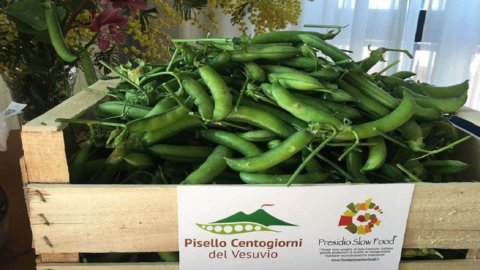Traditionally the sowing coincides with the feast of the Madonna della Neve, when we celebrate the day seven centuries ago when some fishermen from Torre Annunziata pulling their nets between the Scoglio di Rovigliano and the sea of Castellammare di Stabia found a chest entangled inside which was kept the bust of a dark-skinned Madonna with holding a child. The lady became immediately object of worship disputed between the population of Torre Annunziata and that of Castellammare di Stabia. Until a Captain of the people ruled that the law was on the side of the Oplontini. But to dispel any further doubts was a sudden snowfall that fell on the chapel where the sacred image in Torre Annunziata was kept, interpreted as a miraculous indication.
It was therefore a tradition throughout the Vesuvian area to sow in the fertile fields of the volcanic aquifers, immediately after the festival, a particular quality of legumes typical of this area with an original name: i hundred day peas. The reason is easy to say, following the agricultural-peasant salary, yes it began to sow in November in the open field and was harvested, gradually, by hand, in mid-March, exactly after one hundred days, until May with the particularity that it does not require constant irrigation as it absorbs the nutrients it needs from the soils enriched with the minerals of the lava flows.
Sowing in November in the open field, harvesting in mid-March after one hundred days
Exceptionally sweet and tender to the point that it can be eaten fresh to savor all its incredible flavour, one consumes and comes also marketed dry combining very well with meat dishes, but traditionally it is also used in the typical Neapolitan pasta and peas and in the Somma area it goes well with cod.
Unfortunately, despite its extraordinary flavour, the Cento giorni pea has gradually had to give way to more modern and profitable varieties for industrial agriculture.
And this is how the glorious Vesuvius pea, widespread until the 70s, it was included in the categories at risk of extinction. If we talk about it today it is thanks to some local farmers who had saved the seeds, handed down from generation to generation and preserved in the Campanian Horticultural Germplasm bank, and which in 2018 they started a recovery and cultivation project. Then it was fundamental to become a Slow Food presidium, which turned on the spotlight and the interest of a vast public of consumers and enthusiasts.
Widespread since ancient times, rich in healthy properties for the body: iron, calcium, potassium and vitamin C.
An active part of its rebirth is due to the municipality of Trecase. The mayor Raffaele De Luca together with Patrizia Spigno (head of the Slow Food Campania presidia) and Maria Lionelli, trustee of the Vesuvio pipeline, involved eighteen small producers in the enterprise called to be part of the Pisello One Hundred Days of Vesuvius Association: they were recovered small quantities of seeds and a planned cultivation has been started.
Peas in antiquity and the Middle Ages have been a staple food in Europe and the Mediterranean basin since the time of the Greeks and Romans. Dried ones, easy to preserve, constituted one of the main food resources of the poor classes in the Middle Ages, often cooked with lard.
But it is not just a matter of goodness that has determined their diffusion. In fact, peas hide healthy virtues of great importance for the human body. The Veronesi Foundation certifies that this type of legumes they are rich in iron, calcium, potassium and vitamin C. They also contain substances called isoflavones, similar to the estrogens inside our body, useful for preventing osteoporosis and cardiovascular disorders
Also good raw, they absorb the nutrients from the soils enriched with the minerals of the lava flowse
Although they belong to the legume family, such as beans, chickpeas and lentils, compared to their "relatives" peas contain less protein and carbohydrates and more water, which makes them less caloric. Even dietary fiber is present in smaller quantities, but still significant compared to the daily requirement. To the properties already referred to, it must be added that they contain considerable quantities of isoflavones or plant estrogens, capable of interacting with specific estrogen receptors and regulating their effects. And according to recent studies they can help inhibit certain stages of breast cancer development with the fact of affect the production of anti-inflammatories as well as prove useful in preventing cardiovascular disease as they increase the resistance of cholesterol to oxidation, a process which underlies atherosclerosis.





